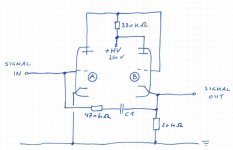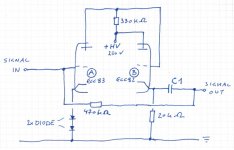I got an old Croft Epoch Elite, but all tubes are removed. I looked at pictures in the internet, but there are many variants of the Elite out there, but not mine. What I can say is, that mine has the socket for the smaller valves (e.g. ECC82). I know that the phonopart works with 3 ECC83. What reamins in question are the two tubes (A and B) of the line level preamp part as shown on the picture (I drew this from my circuit). I cannot find a similar preamp circuit in www.
Anyone got an idea, what tubes A and B could be?
Anyone got an idea, what tubes A and B could be?
Attachments
In your schematic A has its cathode grounded. But your schematic doesn't show how A gets its bias. It could be through grid current biasing, developed over a grid resistor with a very high value (several Mega Ohms). If so, than I think A is a section of an ECC83/12AX7 since other candidates (like ECC81, ECC82, ECC88) are not well suited for grid current biasing. The value of the plate resistor (330K) also points in the direction of an ECC83/12AX7. But if A's bias is fixed (rather unusual for a preamp) I can't say anything about what type of tube A would be.
I would think B will not be an ECC83/12AX7 since its cathode resistor is only 20K. The grid of B is dc-coupled to the plate of A so its DC voltage is just a fraction lower than B's cathode DC voltage. Since there must be some voltage between the catode and plate of A to function properly, the current through the 20K resistor is probably a couple of mA's. An ECC83/12AX7 doesn't pass that kind of current.
Can you show more of the circuit? The output of B must be connected to a blocking capacitor since the DC voltage of the cathode will be positive with respect to ground.
I would think B will not be an ECC83/12AX7 since its cathode resistor is only 20K. The grid of B is dc-coupled to the plate of A so its DC voltage is just a fraction lower than B's cathode DC voltage. Since there must be some voltage between the catode and plate of A to function properly, the current through the 20K resistor is probably a couple of mA's. An ECC83/12AX7 doesn't pass that kind of current.
Can you show more of the circuit? The output of B must be connected to a blocking capacitor since the DC voltage of the cathode will be positive with respect to ground.
Last edited by a moderator:
thank you very much for your expertise!In your schematic A has its cathode grounded. But your schematic doesn't show how A gets its bias. It could be through grid current biasing, developed over a grid resistor with a very high value (several Mega Ohms). If so, than I think A is a section of an ECC83/12AX7 since other candidates (like ECC81, ECC82, ECC88) are not well suited for grid current biasing. The value of the plate resistor (330K) also points in the direction of an ECC83/12AX7. But if A's bias is fixed (rather unusual for a preamp) I can't say anything about what type of tube A would be.
I would think B will not be an ECC83/12AX7 since its cathode resistor is only 20K. The grid of B is dc-coupled to the plate of A so its DC voltage is just a fraction lower than B's cathode DC voltage. Since there must be some voltage between the catode and plate of A to function properly, the current through the 20K resistor is probably a couple of mA's. An ECC83/12AX7 doesn't pass that kind of current.
Can you show more of the circuit? The output of B must be connected to a blocking capacitor since the DC voltage of the cathode will be positive with respect to ground.
Maybe the third tube belongs to the preamp section and not to the phono section. I will enhance the schematic in the next days. It is a fuss to translate the wiring into the schematic and will need some time to make no mistake.
Thanks!!
I tried to ask them, but get no answer. In the net goes the saying that Glenn Croft left business last year.Does Croft still answer the phone/email?
http://www.croftacoustics.co.uk/main.html
By trying to draw the further circuit I came across later made soldering points. I guess, the original circuit had the "signal out" between the 470 kOhm resistor and the C1 cap. So C1 was the blocking capacitor - maybe the preposseser used an unknown blocking capacitor outside of the preamp. The soldering on the other side of the 470 kOhm does not look original, too. Could be that the "signal in" was on a different spot, too, in the original circuit. I will change the "linie out" back to it's original place and make a try with an ECC83 on A and an ECC82 on the B on weekend. It seems that all Croft preamps used a ECC82 on the output side. If that does not work I will go further with making the scheme of the circuit.In your schematic A has its cathode grounded. But your schematic doesn't show how A gets its bias. It could be through grid current biasing, developed over a grid resistor with a very high value (several Mega Ohms). If so, than I think A is a section of an ECC83/12AX7 since other candidates (like ECC81, ECC82, ECC88) are not well suited for grid current biasing. The value of the plate resistor (330K) also points in the direction of an ECC83/12AX7. But if A's bias is fixed (rather unusual for a preamp) I can't say anything about what type of tube A would be.
I would think B will not be an ECC83/12AX7 since its cathode resistor is only 20K. The grid of B is dc-coupled to the plate of A so its DC voltage is just a fraction lower than B's cathode DC voltage. Since there must be some voltage between the catode and plate of A to function properly, the current through the 20K resistor is probably a couple of mA's. An ECC83/12AX7 doesn't pass that kind of current.
Can you show more of the circuit? The output of B must be connected to a blocking capacitor since the DC voltage of the cathode will be positive with respect to ground.
I advise you to check if the cathode of A is really grounded, or perhaps wasn't grounded in the original situation. Grid current biasing or fixed bias both seem a bit unlikely to me.
Thank you. I will look closely at the soldering points of this grounding at the weekend. And I will give feedback what's going on. Since there is no information on the Croft Epoch Elite with the smaller 5+2 tubes (5 in the audio section - inverting the signal, 2 in the PSU-section) in the net I want do develop this topic further.I advise you to check if the cathode of A is really grounded, or perhaps wasn't grounded in the original situation. Grid current biasing or fixed bias both seem a bit unlikely to me.
HelloI advise you to check if the cathode of A is really grounded, or perhaps wasn't grounded in the original situation. Grid current biasing or fixed bias both seem a bit unlikely to me.
I found another dead branch with diodes in the circuit and I guessed, how I could link it. Then I tried it with ECC83 on the A and ECC82 on the B. Only one channel worked, but it worked! I searched another two frustrating hours for an error on the left channel. Than I tried another ECC82 I found on my old Revox G36.
And it worked!!
Thank you very much for your hint regarding the blocking capacitor and an ECC 83 on A. Otherwise I would have given up, I guess. At this timepoint I had rebuilt so much of the Elite already, that I was thinking I destroyed everything.
Now I will insert a new volume potentiometer and I will be done!!!
And as information, my findings:
Croft Epoch Elite with smaller (9-pin) tubes (not the bigger 8-pin tubes, which sound sweeter...) consist in the phono- plus preamp section of 3 ECC83 and 1 ECC82 in non-inverting low-gain preamps and of 4 ECC83 and 1 ECC82 in inverting high-gain preamps.
Attachments
- Home
- Source & Line
- Analog Line Level
- Tubes for Croft Epoch Elite?

